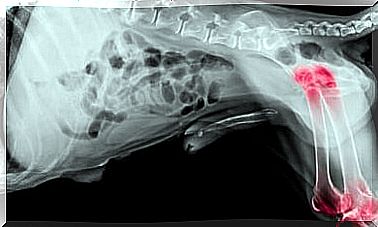Abdominal Pain In Dogs: Signs And Symptoms

Abdominal pain in dogs can panic the owner until he finds out what is wrong with the animal. It’s important to keep in mind that a sore stomach is a fairly common medical problem that can lead to abdominal swelling.
The key is to understand the signs and symptoms. For example, shallow breathing, which can be accompanied by lack of energy and loss of appetite, indicates pain. Today, learn more about possible signs of abdominal pain in dogs.
What defines abdominal pain in dogs?
Various diseases can lead to abdominal pain. Medically, repetitive discomfort in a dog’s abdominal area is known as an acute abdomen. This problem can be infectious or non-infectious in nature.
The pain can be caused by digestion, metabolism, muscular or skeletal problems, or problems with the reproductive or urinary system, among other things.
What can you do with stomach pain?
Although abdominal pain in dogs may be difficult to spot, one should always look for a change in the animal’s behavior. Take your dog to the vet every time you suspect he is behaving differently. In the case of abdominal pain, an underlying disease should be treated immediately, as there may be a health risk such as constipation or a tumor.

Symptoms of Abdominal Pain in Dogs
As an owner who watches their dog on a daily basis, you may notice changes in their behavior that indicate pain. The following warning signals can usually be observed:
- Swollen and tender abdomen
- Vomit
- Loss of appetite
- Whine
- Difficulty breathing or abnormal breathing patterns
- Difficulty getting up or being restless because the dog cannot find a comfortable position
- Diarrhea, bloody or slimy stools, dehydration
- Depression or lack of energy
- fever
Causes of Abdominal Pain in Dogs
There are innumerable reasons why your dog may have an acute abdomen. As mentioned earlier, abdominal pain in dogs is fundamentally divided into two types: infectious and non-infectious. There can be several types of abdominal pain within these two categories:
- Metabolic disorder such as kidney failure, liver disease, malabsorption, ischemia (insufficient blood supply to an organ or part of the body), cancer
- Abdominal cavity, such as urinary tract injury, urethral obstruction, cystitis, peritonitis (inflammation of the peritoneum)
- Digestion, such as stomach torsion, pancreatitis, gastritis, stomach ulcer, bowel inflammation, constipation, or intestinal obstruction
- Reproductive organs, such as prostatitis
- Skeletal muscle, like an abdominal muscle injury
- Neurological disorders
- Bacterial, parasitic and viral infections such as canine parvovirus, leptospirosis, etc.

Veterinary advice
An important part of the diagnosis is the interview. It is important to be prepared for this and to report any observations to the veterinarian. When was the last food intake? What did the animal eat? What are the symptoms?
You should also report if you have visited new places or if your dog may have been exposed to toxins or chemicals. It is also useful to mention if the dog has recently suffered trauma or injury.
After that , the vet may decide to test your dog’s blood and urine. The dog will also be physically examined for signs of trauma such as bruising or blood . The vet also feels the abdomen and examines the lungs and heart.
If necessary, the veterinarian may perform an x-ray, fluoroscopy, and cytological exam to diagnose possible causes. Treatment depends entirely on the cause of the pain.









